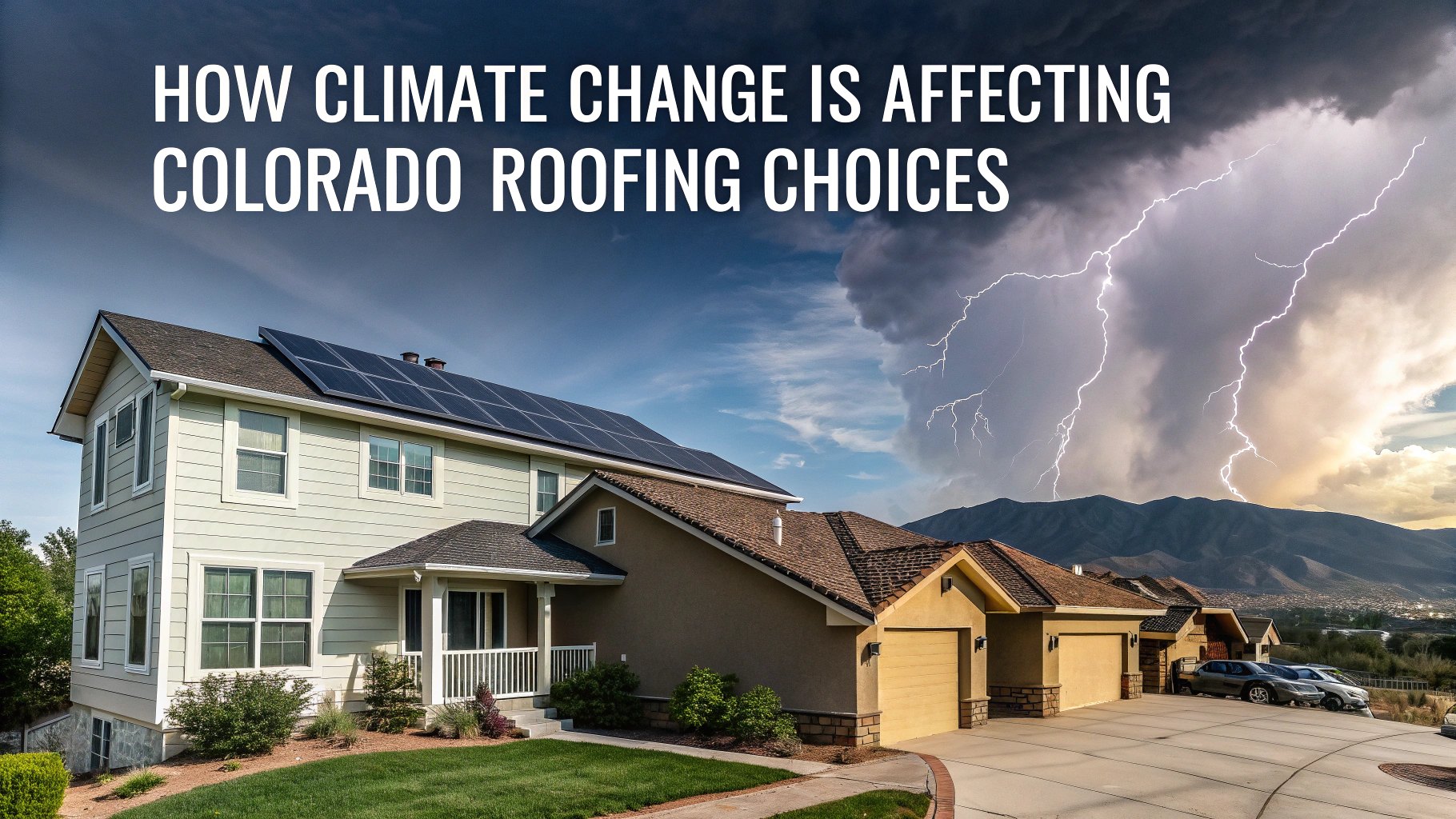Colorado’s unique climate patterns and increasing weather extremes are reshaping how homeowners approach roofing decisions.
Rising temperatures, more frequent hailstorms, and intense UV exposure at high altitudes create special challenges for maintaining durable roofs in the Centennial State.
Smart material choices and adaptation strategies can help Colorado homeowners protect their investments while reducing environmental impact.
Climate Changes Affecting Colorado Roofs
- More frequent and severe hailstorms
- Extended periods of intense heat
- Increased UV radiation exposure
- Dramatic temperature fluctuations
- Heavy snow loads in winter
Climate-Resistant Roofing Materials
Impact-resistant shingles rated Class 4 offer superior protection against Colorado’s intensifying hailstorms.
Cool roofing materials with high solar reflectance help combat rising summer temperatures.
Metal roofing systems provide excellent durability against extreme weather while offering energy efficiency benefits.
| Material | Climate Benefits | Lifespan |
|---|---|---|
| Metal Roofing | Snow shedding, hail resistant | 40-70 years |
| Class 4 Shingles | Impact resistant, weather durability | 30-50 years |
| Cool Roofing | Heat reflection, energy efficient | 20-30 years |
Energy-Efficient Solutions
Solar-ready roofing installations prepare homes for future renewable energy adoption.
Enhanced insulation systems help maintain consistent indoor temperatures despite extreme weather.
Light-colored roofing materials can reduce cooling costs by up to 30%.
Insurance Considerations
Many Colorado insurance companies offer premium discounts for impact-resistant roofing materials.
Documentation of climate-resistant roofing installations can support insurance claims after severe weather events.
Local Building Codes and Requirements
- Class 4 impact resistance requirements in hail-prone areas
- Enhanced wind resistance standards for mountain regions
- Cool roof requirements for certain building types
- Updated snow load calculations for higher elevations
Finding Qualified Contractors
Look for contractors certified in climate-resistant roofing installations through the Colorado Roofing Association (CRA).
Contact the Colorado Roofing Association at (303) 484-0549 or visit www.coloradoroofing.org for verified contractor listings.
Taking Action for a Climate-Ready Roof
Schedule regular roof inspections to identify climate-related wear and damage early.
Consider upgrading to climate-resistant materials during your next roof replacement.
Research available tax incentives and rebates for energy-efficient roofing improvements through the Colorado Energy Office.
Maintenance Tips for Climate Resilience
Regular gutter cleaning prevents ice dam formation and water damage during extreme weather events.
Professional roof inspections twice yearly help identify potential vulnerabilities before major storms.
- Clear debris regularly, especially before storm seasons
- Check attic ventilation systems quarterly
- Monitor for signs of UV damage and material degradation
- Document roof condition with photos annually
Cost-Benefit Analysis
Initial investment in climate-resistant materials typically yields 15-25% longer roof lifespans.
Energy-efficient roofing can reduce annual heating and cooling costs by $200-500 for average Colorado homes.
| Upgrade Type | Initial Cost Increase | Long-term Savings |
|---|---|---|
| Impact-Resistant Materials | 20-30% | $2000-4000/decade |
| Cool Roof Technology | 15-25% | $3000-5000/decade |
| Enhanced Insulation | 10-20% | $2500-4500/decade |
Preparing for Colorado’s Future Climate
Strategic roofing investments today create more resilient homes for tomorrow’s weather challenges.
Combining multiple climate-adaptive solutions provides the best long-term protection for Colorado properties.
Homeowners who act proactively on climate-ready roofing solutions typically see better property values and lower maintenance costs over time.
- Consider future climate projections when selecting materials
- Plan for phased upgrades to spread costs over time
- Stay informed about emerging roofing technologies
- Join local sustainability initiatives for additional resources
FAQs
- How is climate change impacting roofing materials in Colorado?
Climate change is causing more extreme temperature fluctuations, increased hail events, and intense UV exposure in Colorado, leading to faster deterioration of traditional roofing materials and the need for more durable alternatives. - What roofing materials are becoming more popular due to Colorado’s changing climate?
Impact-resistant materials like Class 4 shingles, metal roofing, and synthetic slate are gaining popularity as they better withstand severe weather events and offer improved durability against UV radiation. - How do increased snowfall patterns affect Colorado roofing choices?
Changes in snowfall patterns require stronger roof structures and materials with higher snow load ratings, leading to preferences for steeper pitch designs and materials that prevent ice dam formation. - Are solar-reflective roofing materials worth considering in Colorado’s climate?
Yes, cool roofing materials with high solar reflectance are becoming essential as they help reduce cooling costs during hotter summers and contribute to building energy efficiency. - How do recent climate trends affect roofing warranties in Colorado?
Insurance companies and manufacturers are adjusting warranty terms to account for increased severe weather events, often requiring impact-resistant materials for full coverage benefits. - What role does proper ventilation play in modern Colorado roofing?
Enhanced ventilation systems are becoming crucial as temperature extremes increase, helping prevent moisture buildup, reduce ice dam formation, and extend roof longevity. - How are wildfire concerns influencing roofing material choices?
The rising wildfire risk has led to increased adoption of Class A fire-rated materials like concrete tiles, metal roofing, and specially treated shingles that provide better fire resistance. - What maintenance changes are needed due to climate change effects?
More frequent inspections, enhanced gutter systems, and regular maintenance are required to address increased debris, more severe storm damage, and faster wear from extreme weather conditions. - How do extreme temperature fluctuations impact roofing material selection?
Materials with higher thermal expansion tolerance, such as modified bitumen and certain composite materials, are becoming preferred choices to handle rapid temperature changes without degradation. - What energy-efficient roofing options are recommended for Colorado’s changing climate?
Energy-efficient options including green roofs, cool roofs with high albedo ratings, and integrated solar systems are increasingly recommended to combat rising temperatures and energy costs.
